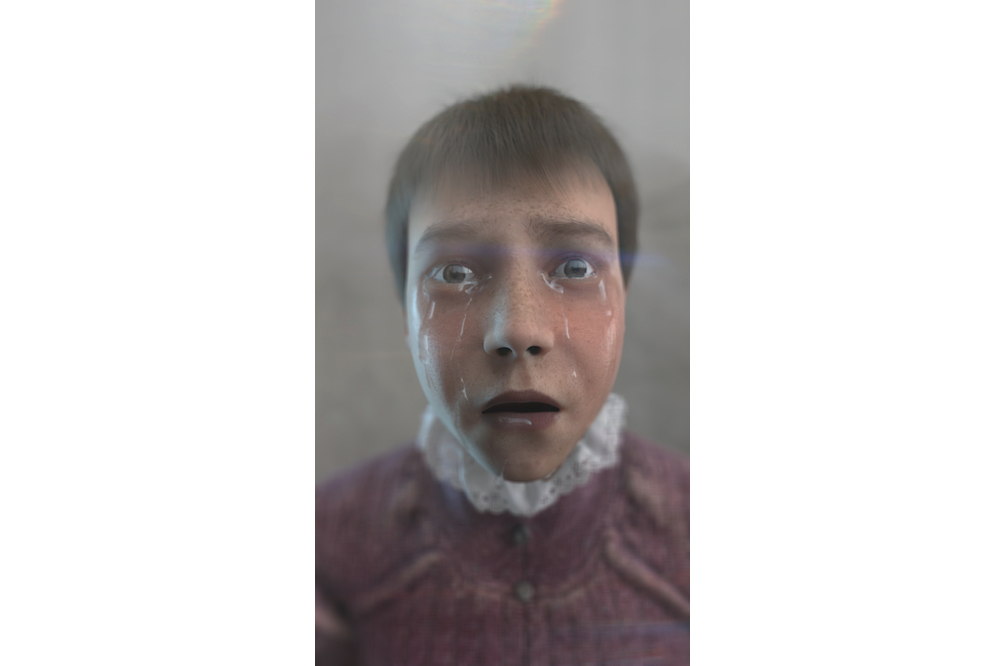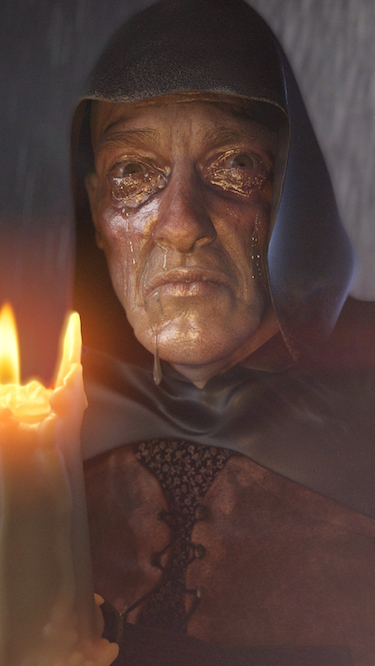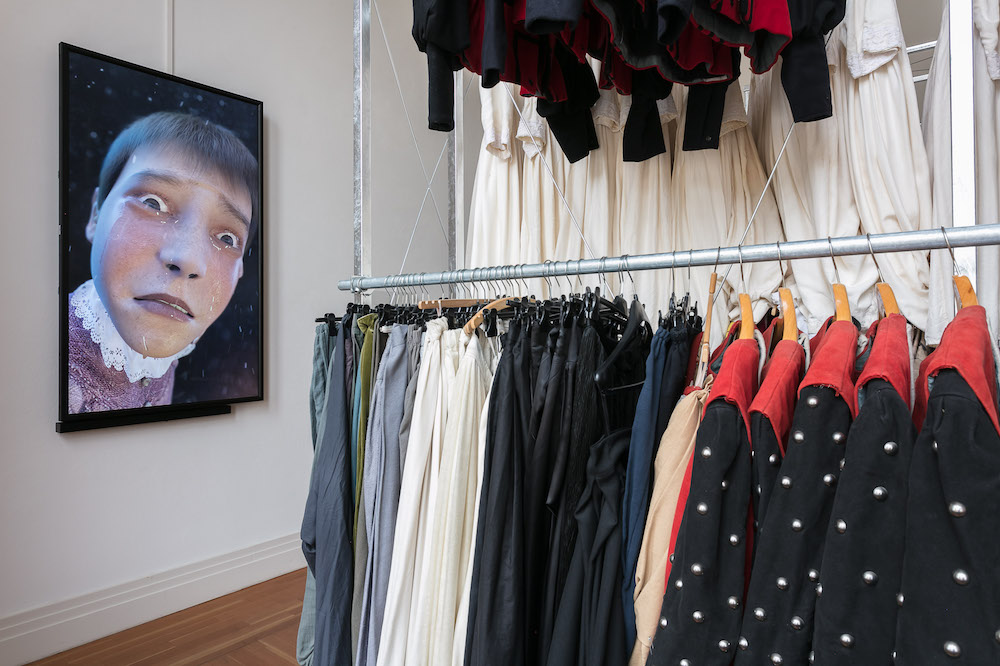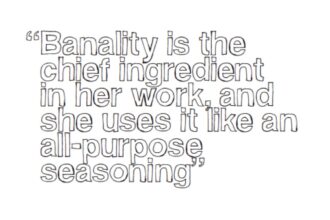Type “Ed Atkins” into Google, and you’ll shortly come face to face with an asshole: not the artist himself – though his smiling visage also appears – but another white man, digitally rendered, gazing blankly, head shaved and mouth ajar. “Asshole” has been jotted backwards on this anonymous doppleganger’s forehead, like some strange stigmata, or the calling card of feminist vigilantes.
The latter would seem appropriate, given the times. Lately, unending accounts of predatory male behavior have flooded social media feeds. Technologies of connectedness, alongside a growing collective resolve, has made it possible for many to name their assaulters en masse. Because of their efforts, it’s become untenable to deny that male sexual entitlement spreads like a cancer, through Hollywood, sports, comedy, corporate culture, and – to the surprise of exactly no one – our sacrosanct artworld. With this shift, the characters who populate Atkins’s animated video works – a homogenous succession of white men and boys – have been ushered into a very harsh light in a new exhibition at Martin Gropius Bau. Atkins’s masculine automatons have always appeared stupefied and gaping, as if stunned by some horrible discovery. But now this expression reads like an internal shock: the deep rot of their own psyches in plain view.
In recent years, the British artist has risen through successive institutional exhibitions to the stratosphere of art stardom. Loosely grouped in the “post-internet” generation for his exploration of digital media and its effects, he also transcends that category with an interest in the human psychological abyss, throwing back to Giacometti, among others. Descriptions of Atkins’s work tend to focus on these pan-human topics. Given the demographic consistency of his subjects, though, these universalist claims have the feeling of a red herring: this work pictures nothing if not a white male’s existential dread, a horrid force in the world lately harnessed by hate groups and demagogues.
Once acknowledged, this reality occasions a dilemma: work like Atkins’s may be opening a window onto a deeper understanding of normative masculinity’s profound fucked-up-ness. On the other hand, it may just be a culturally sophisticated dissimulation mechanism: a performance that allows us to unload those qualities we’d rather disavow onto proxy characters, before carrying on as usual. Complex in execution and context, Atkin’s art makes it easy for critics to skirt this situation. Confirming the masculine obsession with size, Martin Gropius Bau’s website describes Old Food (2017) as his “largest installation to date.” In the same press release, we find theoretical waxing about Atkins’s ability to – take a deep breath – “temper affecting autobiographical figuration with broader issues arising as a consequence of the form’s exponential preponderance.” What you won’t find are mentions of the work’s most obvious subject, all those existentially embattled men.
As part of Old Food, the museum’s expansive halls hang with hundreds of opera costumes draped on enormous steel armatures. The charmingly-shabby vestments gain added life-force from this late nineteenth-century museum: its cracked plaster ceiling revealing a lavishly decorated past. Attached to the walls and nearby scaffolds, digital screens – sometimes single, sometimes tiled to theater-scale – host a digitally-animated dream world, a vibrant uncanny valley. Therein, men perform never-ending repetitive tasks and crowd the screens like children pooling breath on glass. When women appear, they are silhouettes etched into wooden didactic panels, or simply tiny and insignificant.
In this world, a hooded male figure appears at least thrice. Tears flood his sunburnt face, which is sometimes obscured by graphic shapes, or a Facebook logo. In a nearby video a freckled boy also weeps, his tears streaming towards a white, decorative collar, like lifelike nature in some gothic novel. In another image (all are titled together, Old Food) the boy plays piano in an empty room as sunlight pours in through a hole. On another screen, the boy stumbles, on loop, through a meadow. Soon, he’s displaced by a large floating baby, who barges into a cabin lit by candles and a flickering black-and-white TV. Eventually, our hooded protagonist reappears, expiring on the ground, burnt to the point of looking alien. Nobody speaks.
Such images offer plentiful fodder for generally human ruminations; how fantasies of the pastoral signal a desperation to escape our own, hyper-capitalized time; how these bucolic places are fantasia produced by kitsch novels and films; how the ability to imagine oneself escaping into such dream environments indicates a dislocated, comfy privilege. But it’s Atkins’s white male figures who cohere these topics, like decomposing but persistently tacky glue.
Certainly, he’s not the first male artist to plumb the masculine psyche – and to perform this plumbing. Atkins’s obvious antecedent is Ban Jas Ader’s I’m Too Sad to Tell You (1970-71), a series of photographs and films that pictured the Dutch artist sobbing inexplicably. But where Ader’s grainy black-and-white images foregrounded sentimentality and melancholia, bloated grotesqueness characterizes Atkins’s figures. His is the HD atmosphere of Hollywood blockbusters – a form that bears significant responsibility for promulgating the violent, male archetype. More akin to Atkins in sentiment is the late Mike Kelley, whom Eileen Myles, in her new book Afterglow, describes as an exemplar of “pathetic masculinity,” a coded puerility that lives inside emotionally-stunted men. Using blankets and stuffed toys as sculptural material, Kelley enacted a symbolic reacquaintance with repressed aspects of the grown-up self. Understanding the limits of art-as-therapy, he fashioned his work into a kind of cabaret performativity.
Atkins’s version of Kelley’s childish props are the real, physical costumes, which hang near his animated videos. The vestments infuse his digital language with a confused corporeality: the material presence of much hanging fabric and plastic, the labor of costume-making, the aura of performing bodies that inhabit the garments, if only hypothetically. This haunted backdrop is ultimately a setting, meant to enliven the exhibition’s core subject: an inexplicable emptiness causing the men to expiate, weeping. It would be foolish to suggest any catch-all reason for this collective male breakdown. But it’s not hard to find pathways that might lead towards an explanation.
First, there’s the horrible chasm: the stomach-churning realization that you yourself may have been an agent of systemically-condoned abuse and violence. For any reasonably self-aware person, this epiphany might trigger questions about how male sexual psychology became so warped. On this topic, few resources are more helpful than Paul B. Preciado’s 2015 book Testojunkie, which offers a shattering and intoxicating account of how manipulating human desire became a gold-rush industry. Preciado’s account of the technological engineering of desire and sexual identity is vast, and not constrained to men. But the book has a particular resonance with the crisis of male sexual entitlement, as especially evident in the digital pornography industry and advertising. Author bell hooks, too, has consistently offered cogent analyses of the manipulative re-wiring of hetero-normative masculinity. Her book The Will to Change (2004) offers an account of abusive masculine rituals – in the locker room, in the home, in the workplace – laying waste to the empathic potential of men, and training us to reproduce patterns of abuse like a drug addict pursues his fix. This is the buried psychological world in which Atkins’s figures wallow.
As an exhibition, Old Food succeeds because it nests this subject within a world of woven reality, fantasy, and latent memory familiar to us all. In a spirit of criticality inherited from institutional critique, Atkins has wound the work through the museum’s own discursive mechanisms. In place of dull wall texts, he’s hung pieces of cheap wood, burn-etched with rambling screeds that braid bio-political themes with snide commentary on the viewer-museum relationship. One panel hosts the show’s lone acknowledgement of its conspicuous maleness. “This wall text doesn’t know everything,” it admits, before sputtering verbosely about foreskins, testicles, urethras, pricks, and dongers. “Watch for this,” the writing continues. The admonition to keep on the look-out for male genitalia is an appreciable – if redundant – gesture towards acknowledging the meltdown unfolding in (and beyond) this show. As if we really needed reminding.
Walking home from the museum, I texted a friend, to solicit his opinion. “I wasn’t sold,” he replied. His reaction caught me off-guard. Despite my reservations about Atkins’s reception, and some skepticism about the capacity of highly-produced work to critique capitalist spectacle, I had been sold. The work’s vivid echoing of pathological male breakdown was convincing, and my qualms resided more with the inability of critics and journalists to engage the work on these terms. The show posited an abject and overwhelming pathos, in sharp contrast to the platitudes that serve as “apologies” for misogynistic depredations. And if the question of its practical effect remained unanswered, Atkins’s engagement with the museum’s own didactic mechanisms reminded me that we need to think and act for ourselves: that art can only do so much.
Maybe my friend sensed the duplicity involved in this work’s exposure of pathetic masculinity, without any curatorial effort to account for the violent consequences of the warped male psyches depicted. This insincerity feels especially glaring in the clutch of an artworld teeming with no shortage of abusive male behavior. All the integrity of old food.


























A seriously impressive article. Thoroughly enjoyed